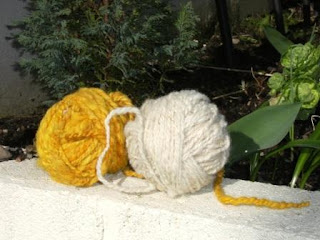Chapter 2 - Natural Dyes and a taste of hand Knitting
When I left you at the end of Chapter 1, I had spent some time on Clare Island (off the west coast) and had spun some amazing yarn from the local sheep. So now I had skeins of spun wool and while the natural colour appealed for many projects, it was time to add a little colour.....
When I left you at the end of Chapter 1, I had spent some time on Clare Island (off the west coast) and had spun some amazing yarn from the local sheep. So now I had skeins of spun wool and while the natural colour appealed for many projects, it was time to add a little colour.....
 For centuries natural dyes have been extracted from roots, stems, leaves, berries and flowers as well as from shell fish and insects and often the formulae were closely guarded secrets handed down through families. One of the most prolific dye sources are lichens which are plant organisms made up of fungus and algae and are usually grey, green or yellow in colour. Traditionally it was the childrens job, after a shower of rain, to collect the wet lichens and, as it was thought to be unlucky for any man to touch the dye pot, only women would dye the wool and cloth.
For centuries natural dyes have been extracted from roots, stems, leaves, berries and flowers as well as from shell fish and insects and often the formulae were closely guarded secrets handed down through families. One of the most prolific dye sources are lichens which are plant organisms made up of fungus and algae and are usually grey, green or yellow in colour. Traditionally it was the childrens job, after a shower of rain, to collect the wet lichens and, as it was thought to be unlucky for any man to touch the dye pot, only women would dye the wool and cloth.
For the purpose of my learning curve I was brought through the process of dyeing the new spun wool with onion skins. First a full pot of the skins, half filled with water is brought to the boil on the stove. The unwound skein of wool is wet thoroughly, alum is added to the water to fix the dye and, once soaked, it is put into the hot pot and simmered gently for up to an hour.
 The skeins are then rinced gently and put outside on the wall to dry in the sun. Further skeins of wool can be added to the pot, undergo the same process and each will come out a lighter shade of orange/yellow. The results are amazing.
The skeins are then rinced gently and put outside on the wall to dry in the sun. Further skeins of wool can be added to the pot, undergo the same process and each will come out a lighter shade of orange/yellow. The results are amazing.
Once your yarn is dried and wound it is ready to be transformed. My grandmother would use some of the undyed wool to make socks and jumpers for the family. The remainder would be send to the local weaver to make blankets (more on weaving in a later article).
Below is a cushin cover I knit using some traditional aran stitches i.e. cables and blackberry. In my next article I will explore the origins of handknitting in Ireland and also have a look at the weaving of the multicoloured sash or belt known as the crios.
 As always I welcome any comments on this article and ideas for future explorations. If you are a crafter who would like to be linked to any of the series of articles please let me know.
As always I welcome any comments on this article and ideas for future explorations. If you are a crafter who would like to be linked to any of the series of articles please let me know.Mo
aka http://www.huggleknits.etsy.com/
Next article due 29 April.........

Loved the 1st part of your series and enjoyed the 2nd part. look forward to reading about weaving as I saw a BBC program about it. I couldn't believe the work, patience and discipline that goes into weaving as well as a love of colours and design. Great altogether!
ReplyDeleteI love natural dyed pieces. I once saw a jumper in New Zealand entirely made from lots of different natural dyed wool and it astonished me!
ReplyDeleteVivi, I've seen other programs in that series, by Monty Don, it's a brilliant series!
Thanks Mo, I am really enjoying your series. I love how the traditional methods of crafting are still used, such as onions for dyeing etc. Let's hope they are passed on for many generations yet.
ReplyDeleteHi. I'm not a spinner or a dyer so forgive my possibly naive question - if you're simmering the wool for upto an hour, doesn't it shrink terribly? thanks!
ReplyDeleteReally interesting. I've heard of berries being used for dye but never onion skins. Recycling at its best!
ReplyDeleteWhat a shock never thought of onion skins, would wearing a knitted jumper of wool dyed by onion skins bring tears to your eyes........ Keep up the writing....very good. Fintan
ReplyDeleteOnions - Wow. Never in a million years would I have thought of that. Your series is great Mo, I'm really enjoying it & am looking forward to the next part.
ReplyDeleteLove your series - as a knitter, I love love love working with natural fibres!!! I have yet to try dyeing with onion skins or berries - so far I've only used commercial dies.
ReplyDeleteI definitely have to try this!
Evening all.....
ReplyDeletethank you so much for your comments.
I know what you mean about the long simmer of the wool, I would have though it would shrink too but Beth kept it just barely cooking and it worked - have not tried it on my own yet.
Cheers
Mo